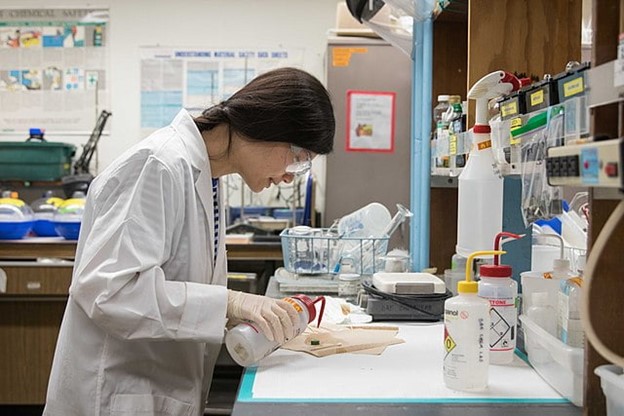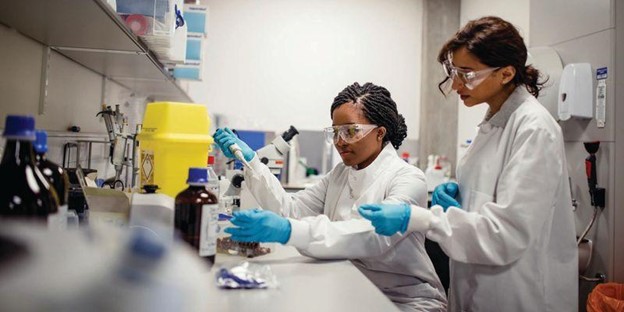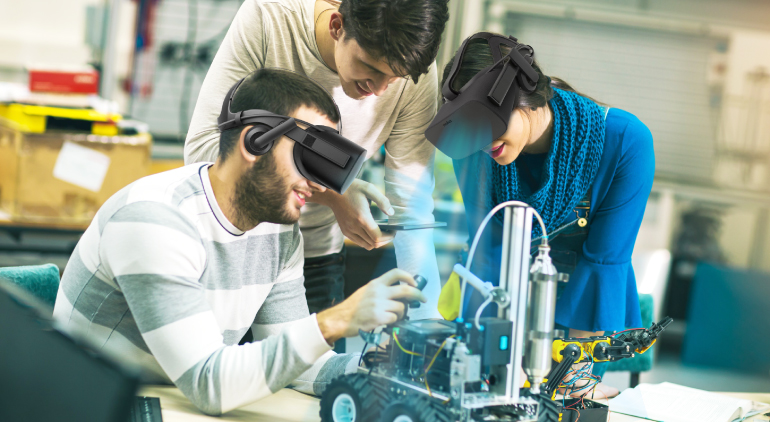The Essential Lab Safety Rules Every Student Should Know

Science is an exciting journey of exploration. However, as scientific exploration and discovery continue to advance, laboratories have become intriguing fields where students engage in hands-on experiments and research.
It is fun but we need to be careful because there are some potential dangers in the lab. That's why lab rules are important!
In this blog, we'll talk about the most crucial lab safety rules for students should know. We'll learn how to spot potential dangers, be careful in our actions, and follow safety rules to make the lab a safe and awesome place for learning and discovery.
So, Let's dive in and explore the secrets to staying safe in the lab!
Lab Safety Rules for Students
Laboratories are hubs of hands-on experiments and research, where students explore the wonders of science. However, the potential hazards that accompany such experiences demand a cautious and responsible approach.
Laboratory Safety Introduction
When it comes to working in a lab, safety should always be the number one priority.
Laboratories are unique environments where students engage in hands-on experiments and research, but they can also present potential hazards that must be understood and mitigated.
Laboratory safety introduction is the foundation upon which fruitful scientific exploration is built.
By understanding potential hazards, emphasizing cautious behavior, and acknowledging the consequences of disregarding safety protocols, students can create a secure and conducive environment for learning and discovery in the chemistry and science lab.
1. Potential Hazards in a Lab
Laboratories house various chemicals, equipment, and procedures that can pose risks if not handled properly. Chemical spills, fires, explosions, and exposure to toxic substances are some of the potential hazards students may encounter.
By recognizing these risks, students become aware of the necessity for taking necessary precautions and adopting a safety-first mindset.
2. Need for a Cautious and Responsible Behavior
In any laboratory setting, cautious and responsible behavior is non-negotiable. Students must follow instructions meticulously, be attentive, and avoid any shortcuts.
Complacency or carelessness can lead to serious accidents that may not only harm the individual but also jeopardize the safety of others in the vicinity.
3. Consequences of Neglecting Safety Protocols
Neglecting safety protocols can result in dire consequences. Accidents may lead to injuries, property damage, and even legal repercussions.
Additionally, neglecting safety can hinder the learning process, as students may be hesitant to engage fully in experiments if they feel unsafe.
Also Read: 5 Creative Ways to Teach Turbofan Jet Engine
Why Is Lab Safety Important
The integrity of the experiments being carried out and the safety of those working in laboratories are both guaranteed by lab safety. Accidents, injuries, and exposure to dangerous chemicals are all prevented. Following lab safety regulations also protects the validity and dependability of experimental findings, increasing research and supporting scientific correctness.
Safe Lab Practices
 Source: ChemTalk
Source: ChemTalk
In the laboratory, practicing safety goes hand in hand with scientific exploration. Adopting safe lab practices ensures that students can conduct experiments and research with confidence while minimizing the risk of accidents and injuries.
Adhering to safe lab practices not only safeguards the well-being of students but also enhances the accuracy and reliability of experimental results.
By establishing a culture of safety, educators instill valuable habits that students can carry forward into their future scientific endeavors.
1. Proper Handling and Storage of Chemicals
Chemicals are an integral part of laboratory work, but they can be hazardous if mishandled. It is crucial for students to be well-informed about the properties of each chemical they are working with and to follow precise procedures for their handling and storage.
This includes using the correct labeling, storing chemicals in designated areas, and avoiding incompatible combinations that could lead to reactions.
2. Wearing Appropriate Personal Protective Equipment (PPE)
Personal Protective Equipment (PPE) is the first line of defense against potential hazards in the lab. Students should wear the necessary gear, such as lab coats, safety goggles, gloves, and closed-toe shoes, to protect themselves from chemical spills, splashes, and other accidents.
Properly fitted PPE can significantly reduce the risk of exposure and injury.
3. Preventing accidents with good lab hygiene
Maintaining good lab hygiene and organization is essential for accident prevention. Keeping the workspace clean and uncluttered reduces the likelihood of accidental spills or tripping hazards.
Properly disposing of waste materials and cleaning up after experiments are equally important. Additionally, students should be aware of emergency exits and safety equipment locations in the lab.
Science Lab Safety Rules
Laboratory safety rules are the backbone of a secure and conducive learning environment in science labs.
By providing students with detailed explanations of essential science lab safety rules, emphasizing proper handling of chemicals and equipment, educating them about fire safety and emergency procedures, stressing the importance of waste disposal, and instructing them on dealing with accidents and injuries, educators can foster a culture of safety that empowers students to explore the wonders of science with confidence and responsibility.
Detailed Explanation of the Most Crucial Science Lab Safety Rules
A comprehensive understanding of the most crucial lab safety rules is the foundation of a safe laboratory experience.
These rules encompass various aspects of safety, including personal protective equipment (PPE) requirements, specific protocols for different experiments, and guidelines for handling emergencies.
Educators should thoroughly explain and emphasize these rules to students before they commence any lab work.
☑️ Handling of Chemicals and Equipment
Proper handling of chemicals and lab equipment is a cornerstone of lab safety.
Students must be educated on how to measure, mix, and use chemicals safely. This includes understanding chemical compatibility, avoiding cross-contamination, and following precise instructions for experiments.
Mishandling chemicals and equipment can lead to hazardous situations, making this rule of paramount importance.
☑️ Fire Safety and Emergency Procedures
In any lab setting, the risk of fire and other emergencies cannot be overlooked. Students should be acquainted with the location and operation of fire extinguishers, emergency showers, and eyewash stations.
Furthermore, they must know how to respond to fire incidents and other emergencies, such as chemical spills or injuries, swiftly and calmly.
☑️ Proper Disposal of Waste Materials
The proper disposal of waste materials is an essential aspect of lab safety and environmental responsibility. Students should be aware of the designated waste disposal areas and the specific requirements for each type of waste.
Incorrect disposal could lead to chemical reactions, environmental contamination, or potential harm to lab staff.
☑️ Dealing with Accidents and Injuries
Despite all precautions, accidents can still occur in the lab. In the event of an accident or injury, students should know the appropriate procedures to follow.
This includes seeking immediate medical attention for injuries, reporting incidents to the lab supervisor, and documenting the details of the accident for future reference and improvement.
Also Read: A Guide to Virtual College Tours: Exploring Campuses from Anywhere
Lab Safety Guidelines

Source: Lab Manager
Lab safety guidelines serve as a vital complement to general safety rules, providing students and researchers with a comprehensive approach to safety.
By offering specific safety guidelines for experiments and activities and addressing the safety concerns inherent in different lab setups, educators create a safer and more enriching laboratory environment for scientific exploration and discovery.
☑️ Additional Guidelines for Specific Experiments and Activities
Different experiments and activities require tailored safety guidelines to mitigate specific hazards.
For instance, experiments involving volatile substances may demand additional ventilation measures to prevent the buildup of harmful fumes.
Similarly, procedures that produce aerosols might necessitate the use of specialized respiratory protection.
By outlining these specific guidelines, students can approach each experiment with a deeper understanding of the associated risks and appropriate safety measures.
☑️ Addressing Safety Concerns for Different Lab Setups
Laboratories come in various setups and configurations, each presenting its unique safety considerations. For instance, chemistry labs, biology labs, and physics labs may have distinct safety requirements based on the nature of their experiments.
Additionally, university research labs and K-12 educational labs may differ in the level of expertise and supervision, leading to variations in safety protocols.
Addressing these differences through tailored safety guidelines ensures that all labs, regardless of their setup, uphold the highest safety standards.
By incorporating additional guidelines for specific experiments and addressing safety concerns for different lab setups, educators can empower students to conduct experiments with a heightened awareness of safety.
It encourages a proactive approach to safety and reinforces the idea that safety measures should be customized to suit the unique demands of each scientific endeavor.
Safe Laboratory Procedures
When conducting experiments in the laboratory, following safe laboratory procedures is paramount to safeguarding the well-being of students and researchers.
A step-by-step guide to maintaining safety during experiments, along with effective communication and teamwork, forms the backbone of a secure and productive lab environment.
☑️ Step-By-Step Guide to Maintaining Safety During Experiments
Measure 1: Preparation and Planning: Before commencing any experiment, students should thoroughly read and understand the procedure. This includes identifying potential hazards and ensuring the availability of necessary safety equipment and personal protective gear.
Measure 2: Workspace Setup: Organize the workspace to minimize clutter and create clear pathways. Ensure all necessary equipment and chemicals are within reach to avoid unnecessary movements during the experiment.
Measure 3: Handling Chemicals: Follow precise instructions for the handling and storage of chemicals. Be mindful of chemical compatibility and potential reactions, and always use appropriate safety labels.
Measure 4: Personal Protective Equipment (PPE): Wear the necessary PPE, such as lab coats, safety goggles, gloves, and closed-toe shoes, to protect against chemical splashes, spills, and potential injuries.
Measure 5: Ventilation and Fume Hoods: When working with volatile substances, use fume hoods to prevent the buildup of harmful vapors. Ensure proper ventilation in the lab at all times.
Measure 6: Equipment Inspection: Before using lab equipment, inspect it for any damages or malfunctions. Report any issues to the lab supervisor or technician immediately.
Measure 7: Proper Measurements: Use calibrated instruments for accurate measurements, and double-check measurements before proceeding with the experiment.
Measure 8: No Eating or Drinking: Emphasize the importance of not consuming food or beverages in the lab to avoid accidental ingestion of hazardous substances.
Measure 9: Communication: Establish clear communication channels among lab members. Inform team members about the experiment's progress, any observations of concern, and any deviations from the expected outcomes.
Role of Communication and Teamwork in Lab Safety
Effective communication and teamwork are vital components of lab safety. Students should feel comfortable discussing safety concerns with their peers and lab instructors. Open dialogue encourages a proactive approach to identifying and addressing potential hazards.
Teamwork also plays a critical role in lab safety. In a collaborative environment, students can watch out for each other and assist when needed.
Team members can share responsibilities, such as monitoring experiments and ensuring that safety protocols are followed diligently.
Encouraging a culture of safety-conscious communication and teamwork fosters a sense of responsibility and accountability among lab participants.
By working together, students can create a safer and more supportive laboratory environment, leading to enhanced scientific learning and discovery.
Also Read: The Future of Healthcare: Transforming the Patient Experience with Immersive Technologies
Introducing the Concept of Virtual Reality (VR) Labs
In this era of rapid advancement, technology is permeating various aspects of our lives. Embracing progress has become crucial across diverse fields, and education, especially in the world of science, stands to benefit immensely from technological integration.
As technology continues to evolve, traditional teaching methods are proving insufficient to fully engage and prepare today's students for the challenges of tomorrow.
 Get the App from Meta Store: Download Now
Get the App from Meta Store: Download Now
Science education must adapt to equip students with the necessary skills and knowledge in a world shaped by science and technology.
The introduction of Virtual Reality (VR) labs represents a significant transformation in science education.
Leveraging VR technology, educational institutions can create immersive and interactive learning experiences that transcend the limitations of traditional classrooms and laboratories.
VR Labs increase students' engagement. Through VR labs, students can explore complex scientific concepts through simulated experiments and real-life scenarios within a safe and controlled environment.
By embracing VR labs in science education, institutions can not only enhance student engagement and motivation but also find cost-effective solutions.
Reducing reliance on expensive laboratory equipment and materials makes science education more accessible and scalable, empowering students from diverse backgrounds to experience cutting-edge learning opportunities.
Moreover, integrating VR labs in the metaverse adds a thrilling dimension to science education.
The metaverse, a shared virtual space where real-time interactions occur, fosters collaborative learning opportunities beyond geographical boundaries.
In this interconnected global learning community, students can engage in group projects, knowledge-sharing, and interactive discussions with peers and educators from around the globe.
Also Read: How to set up VR lab in universities and colleges?
Why Engineering Colleges Should Consider VR Labs?

If you belong to an engineering college, You must be wondering “Why engineering colleges should consider VR Labs?”
Well, the adoption of VR labs in engineering colleges brings a myriad of benefits, catering to the specific needs of engineering students, preparing them for the modern workplace, and offering cost-effective scalability.
By integrating VR technology, engineering colleges can elevate the learning experience, empowering students with the skills they need to thrive in a technology-driven world.
"Unlock the potential of tomorrow's engineers today with VR Labs, where hands-on experience meets digital innovation for unparalleled learning."
1. Specific Benefits for Engineering Students
The benefits of VR labs are endless. It offers engineering students a highly interactive and immersive learning experience.
They can engage in realistic simulations of complex engineering processes and experiments, allowing them to grasp intricate concepts with greater clarity.
Additionally, VR labs enable students to practice problem-solving skills in a risk-free environment, building their confidence and proficiency.
2. Prepare Students for Modern Workplace Requirements
In today's technologically driven workplace, proficiency in virtual environments is increasingly essential. By utilizing VR labs, engineering colleges equip their students with practical skills that align with modern industry demands.
Graduates who have experienced VR labs are better prepared to adapt to cutting-edge technologies and excel in their careers.
3. Cost-effectiveness and Scalability of VR Labs in Colleges
Compared to traditional physical labs, VR labs offer significant cost savings in terms of equipment, maintenance, and consumables.
Moreover, they can be easily scaled to accommodate more students without incurring additional costs.
This makes VR labs a cost-effective solution, particularly for colleges with limited resources and space constraints.
Conclusion
In conclusion, lab safety rules remain of utmost importance for every student engaged in scientific exploration.
By adhering to these guidelines, we ensure a secure and conducive learning environment, fostering a culture of responsibility and care.
However, the adoption of VR labs represents a transformative step in enhancing science education. The immersive and interactive experiences provided by VR technology open new horizons for students, boosting their engagement, motivation, and understanding of complex scientific concepts.
Why are lab rules important, you might wonder? Well, lab rules are crucial to ensure the safety and effectiveness of these virtual laboratories, making it imperative for students to learn and adhere to them.
While VR labs offer unprecedented advantages, we also recognize the value of traditional labs in fostering hands-on experiences and practical skills.
The synergy between traditional and virtual labs holds the key to the future of learning, where students can access a diverse range of learning environments tailored to their needs.
At iXR Labs, We at iXR Labs, tailor unique and futuristic VR Content for Engineering, Medical, and Sciences Students and help institutes build VR Labs to change the way students interact and experience reality.
If you are interested in giving this technical edge to your college/ university or wish to know more about how to set up VR Labs in your institutions, you can visit www.ixrlabs.com




